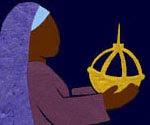The war chapters in Alma have come and gone, and I haven't posted any reflections about them. I guess that will have to wait until another Book of Mormon cycle. Today I want to reflect on the "pentecostal outpouring" story in Helaman 5.
Let's recap the story: Nephi and Lehi are preaching to the Lamanites (who have recently conquered the land of Zarahemla). They are thrown into prison for "many days" until finally their captors—Lamanites and Nephite dissenters—decide to execute them. At that moment, God intervenes, encircling Nephi and Lehi with pillars of fire. At this, we're told, Nephi and Lehi "take courage," which I like because it implies that they had been frightened before that, i.e., they're human, not heroically fearless, stalwart figures. Nephi and Lehi tell the crowd (there's about 300 people, we're told in v. 49) not to be afraid—but they are anyway, because of the dark cloud and the prison walls shaking. Meanwhile, God speaks to them in what we are told is not a "voice of thunder" or "tumltuous noise" but a "still voice of perfect mildness, as if it had been a whisper" which pierces them to the core—but which also causes the earth and the building to shake.
Now I want to pause for a moment and try to really get that picture in my head. So we have this chaotic scene—pillars of fire, earthquake. If this were a Hollywood movie, we'd have lots of noise in the background: a blowtorch-kind of sound coming from the pillar of fire, that rumbling noise they use for earthquakes, creaking timbers, and so on. But it's not entirely clear to me if that's what we're supposed to be imagining here. Maybe, maybe not. The walls aren't actually falling after all, so you're not going to have the sound of timbers breaking and stones falling to the ground; and I confess I don't really know the physics of fire, but if this substance that looks like fire isn't actually burning anything, then it wouldn't be making noise, would it, since it isn't using up oxygen? So should we be imagining this tumultous scene unfolding, counterintuitively, in near silence?
I don't know. My point is: Whether we're supposed to imagine a lot of "background noise" or not, the central event that's taking place here—God communicating with the crowd—isn't noisy at all. That is nearly silent. There's no rumbling bass when God speaks, just a whisper. It's a whisper that appears to have the power to make the earth shake. But it's still a whisper. When you encounter God, this story's saying, you encounter an awe-ful, disruptive, even terrifying power; but at the heart of all that, you encounter stillness, mildness, and an injunction not to be afraid.
But this crowd is afraid, which means they're not yet responding to God the way God desires them to. Cut to the chase: Aminadab, the Nephite dissenter, tells the crowd that they need to "cry to the voice, even until you shall have faith in Christ." Note the counterintuitive cause-and-effect there: prayer leads to faith, not the other way around. So everyone in the crowd begins to pray; the dark cloud is dispersed; and they become aware that every one of them is encircled in a pillar of fire just like Nephi and Lehi. The Holy Ghost falls on them so that they "speak forth marvelous words"; they are filled with joy; a voice whispers peace. Like Nephi and Lehi, they look up and converse with angels.
Reading the story this time around, I was struck by the image of an entire crowd encircled in fire. That is to say, the entire crowd is brought together into God—into a common experience of joy and peace and personal revelation. And this happens through prayer. By talking with God, they are brought into relationship with God—the God of stillness and perfect mildness. This is not a relationship based on fear of God; on the contrary, the point is to dispel their fear. They are afraid of God only so long as they are not in relationship with God: they are afraid of God only until they get to know God.
This entering into relationship with God occurs individually. But by entering into relationship with God, individuals come to form part of a community, the community of all those who are likewise in relationship with God. To shift to a Christian vernacular less familiar to Mormons but which ought to have special resonance for Mormons: this is the communion of saints. Helaman 5 thus gives us an image, or icon, of the church. The church, the body of the Saints, is a community of individuals who have entered into personal relationship with God. It is a community of Spirit-filled individuals, each of whom is inspired to "speak forth marvelous words" and each of whom is engaged in his or her own personal correspondence with heavenly beings. Note that this is not a hierarchical vision of the church community. It's not that Nephi and Lehi are communicating with angels and then passing their words on to the crowd, who gather around waiting for the appointed mouthpieces to speak. Everyone is a mouthpiece; everyone is conversing with angels; everyone is receiving their own revelation. Note, too, incidentally, that Nephi and Lehi (and, I presume, the rest of the crowd) aren't just listening to what the angels have to say: they're in conversation with them.
I really like this image. I like the egalitarianism of it. I like the individualism of it. I like the way it emphasizes personal revelation and personal relationship with God. The Mormon tradition tends to be preoccupied with images of hierarchical authority, and it's refreshing to have an alternative.
Sunday, August 17, 2008
Subscribe to:
Post Comments (Atom)


No comments:
Post a Comment